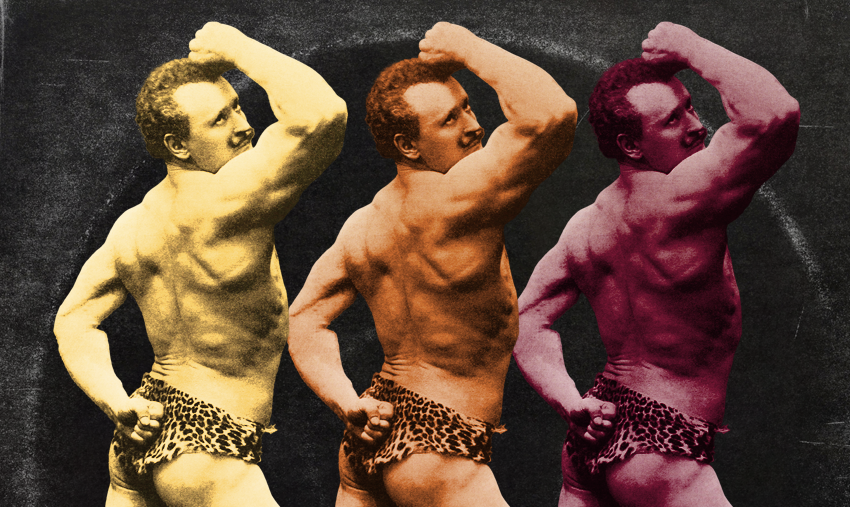Elementary, my dear Squatson
How Sherlock’s creator befriended a musclebound mogul, and watched dozens of dudes preen in pelts

“My eyes are up here.” Sandow in 1902
By the time the 1800s were inching towards their final years, it was pretty good to be Eugen Sandow. The Prussian-born wrestler, bodybuilder and all-around strongman had been a breakout star at the 1893 World’s Fair, Thomas Edison had filmed him flexing his meaty biceps, and he was running his own gym in central London.
He was also a straight-up music hall star, sending entire crowds into a frenzy by striking a couple of poses onstage. He sold out theaters throughout England, and would tear apart entire packages of playing cards, support a battalion of soldiers on his back, and bend iron bars, all while wearing “little more than a fig leaf and a pair of tights.”
“Those at the back of the room leapt on the chairs: paraquet-like ejaculations, irrepressible, resounded right and left; tiny palms beat till…gloves burst at their wearer’s energy,” one newspaper wrote of Sandow’s tremendous appeal in 1890. “And when Sandow, clad – a little in black and white, made the mountainous muscles of his arms wobble! Oh ladies!”
Sandow wasn’t content to show off his own well-sculpted shoulders: he also tried to educate and encourage others to build their bodies through weightlifting and calisthenics. In his magazine — yes, he also wrote and published one of those — he started running ads for a competition, one that would “afford encouragement to those who are anxious to perfect their physiques.”
After three years, and several regional competitions for would-be competitors (all judged by one Mr. Eugen Sandow), he announced that the main event, called The Great Competition, would be held on Saturday, September 14, 1901, at London’s Royal Albert Hall. The winner would receive a cash prize of 1,000 guineas and would get a two-foot tall gold trophy that looked like, uh, Eugen Sandow. Second and third place were also up for cash prizes…and slightly smaller Sandow-shaped trophies.
The competition judges were You-Know-Who, along with rower/sculptor Sir Charles Bennett Lawes, and Sherlock Holmes creator Sir Arthur Conan Doyle. In his autobiography, Memories and Adventures, Doyle wrote that he’d “taken a course of muscular development” with Sandow, and they’d become friends.
On the night of the competition, the hall was packed to the absolute rafters with over 15,000 spectators, and ushers had to turn hundreds of others away. The show opened with a tribute to U.S. president William McKinley, who had succumbed to his gunshot wounds earlier that day. Then, after an undercard of other performances, the crowd finally got what they came for: A procession of 60 competitors flexing their way onstage, accompanied by the song “March of the Athletes,” written by — guess who? — Eugen Sandow.
The judges brought the contestants onstage in groups of 10, and carefully studied each one of them. According to reports from that night, Sandow “fairly went on his hands and knees to examine the nether limbs of men.” After Sandow gave his own lengthy performance, twelve finalists came back to the stage – all wearing black tights and leotards and, for some reason, full leopard skins. They all had to go through a series of poses while standing on pedestals.
“[I]t became excessively difficult, for they were all perfectly developed athletes,” Doyle wrote. “Finally… we got down to the three winners… all wonderful specimens, but one was a little clumsy and another a little short, so we gave the valuable gold statue to the middle one.”
The “middle one” was William L. Murray, who was presented with that golden Sandow trophy and the title of “The Best Developed Man in Great Britain and Ireland.” He was also the guest of honor at a champagne-soaked afterparty. When their night finally wound down, Doyle saw Murray wandering around outside, lugging his gold trophy around with him. “He confided to me that he had no money, but he had a return ticket to Bolton or Blackburn, and his idea was to walk the streets until a train started for the North,” Doyle wrote.
“I suggested that he should come back with me to Morley’s Hotel, where I was residing,” Doyle wrote. “We could not get a cab, and it seemed to me more grotesque than anything of Stevenson’s London imaginings, that I should be wandering round at three in the morning in the company of a stranger who bore a great golden statue of a nude figure in his arms.”
Regardless, The Great Competition was a success, and is considered to be the birth of the modern bodybuilding contest. Over a century later, the Sandow trophy is still bodybuilding’s top prize, going to the winner of the prestigious Mr. Olympia competition; Arnold Schwarzenegger took home seven of them.
Those leopard skin posing outfits, though, were left in Edwardian London where they belonged.
